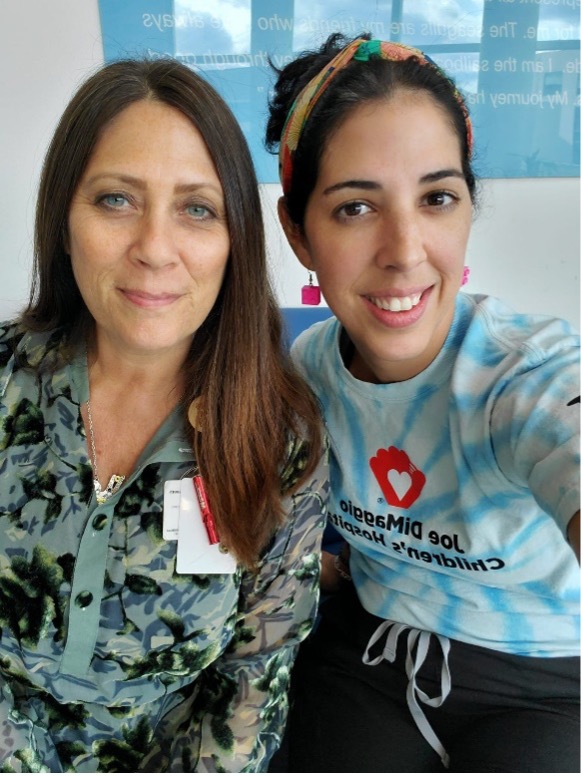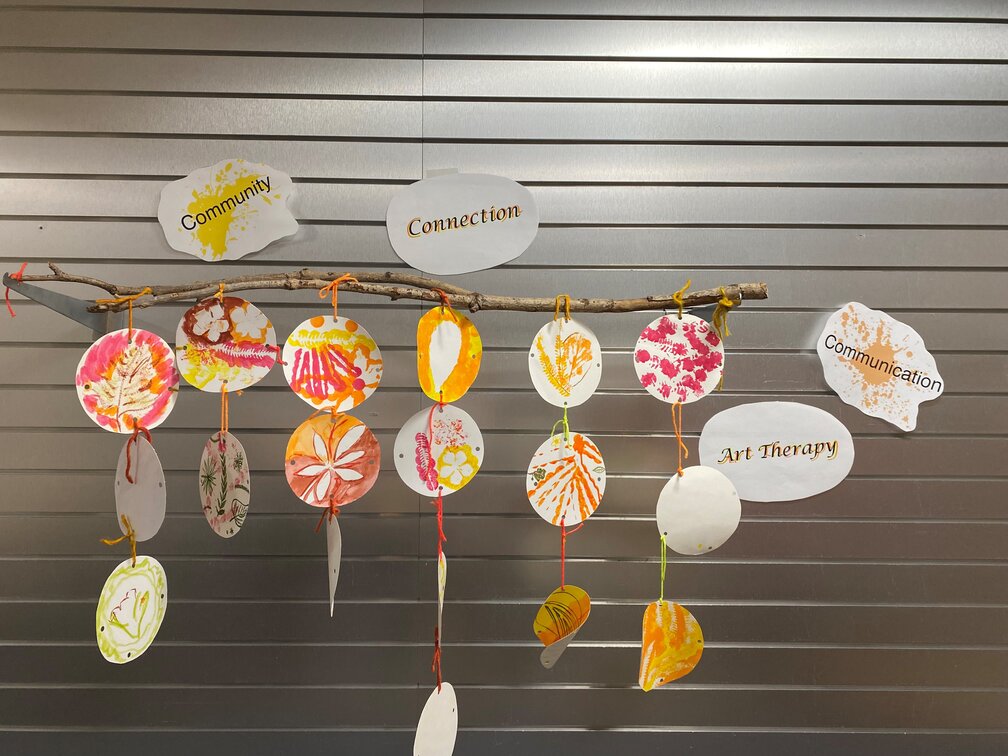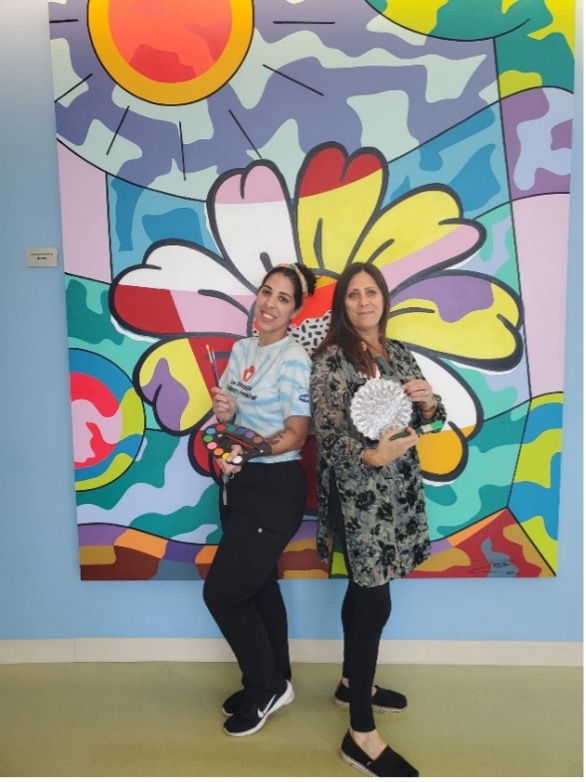April 15, 2024
Lisa Wasserman, PsyD, ATR-BC, ATCS, and Lourdes Figueroa, MPS, ATR, provide art therapy services at the Memorial Regional Hospital (MRH) Department of Behavioral Health and Joe DiMaggio Children’s Hospital of South Florida (JoeD), both in Hollywood, Florida. On any given day, you will see these two interacting with the patients, staff, and families—and providing a service like no other.
Creative Arts Therapies Week provided Dr. Wasserman and Ms. Figueroa an opportunity to celebrate the profession, recognize the excellent therapeutic sessions available within their hospitals, and educate patients and staff about art therapy.
We asked “Dr. W” and “Lulu”, as they are known, about Creative Arts Therapies Week and more broadly about art therapy in a hospital setting.

AATA National Office Question: Tell us about the two hospitals where you serve as art therapists.
Dr. W and Lulu Answer: The professionals at Memorial’s Behavioral Health Services diagnose and treat mental illness, psychiatric disorders, and substance abuse issues. We have created a safe and therapeutic environment at Memorial Regional Hospital for those who need immediate inpatient psychiatric treatment. The art therapy services are part of the group and individual services.
At Joe DiMaggio Children’s Hospital, art therapy is utilized to support the social, psychological, emotional, developmental, and physical needs of children who are patients there as well as their families.
Q. How did you celebrate Creative Arts Therapies Week?
Dr. W: I saw the week as an opportunity to educate others about art therapy as well as offer a resilience-building art therapy experience for the patients and staff at MRH. As part of this, we were also able to thank the hospital’s administrative leaders and art therapy donors for their support and take a moment to recognize the excellent therapeutic sessions offered at MRH. And, of course, we stressed the need for ongoing help with passing art therapy licensure in the Florida legislature!
Lulu: During Creative Arts Therapy week at JoeD, I facilitated an art therapy group in the Child Life Zone and provided educational material for staff, patients, and their families. My goal was to familiarize them with how art helps children cope with their hospital experience by providing a safe and developmentally appropriate way to express themselves. JoeD’s administration also got the opportunity to shadow me and experience the benefits of an art therapy session through a mock one-on-one session.
Q. What does art therapy at your hospitals look like?
Lulu: At JoeD, the Creative Arts Therapy team is made up of two music therapists and one art therapist. We work under Child Life, and as the only art therapist on the pediatric side, I work in every department as consulted. I work in the hospital’s inpatient and outpatient units, including intensive care and step down, cardiac, medical-surgery, hematology-oncology, dialysis, infusion, and provide caregiver support, as needed, in the NICU.
I primarily support patients with individual art therapy at bedside and through group sessions on the units or in our Child Life Zone. Art therapy sessions look different depending on each individual’s unique needs, but common goals in this setting include uncovering/calling attention to strengths, exploring/identifying fears and uncertainties, enhancing communications, building self-esteem, reducing anxiety, managing pain, and enhancing sense of control.
Many medical interventions place a patient in a passive role in their treatment. Art therapy provides an opportunity for active involvement in the creative process, which can help alleviate feeling of helplessness and lack of control often associated with illness and hospitalization.

Lulu at JoeD with her art cart
Photo from Instagram
Dr. W: The Memorial Behavioral Health units have a team of therapists under the director of psychological services. I’m the clinical art therapist that has provided services here for the past 26 years! Memorial is an acute, Level 1 trauma center with a four-story building that treats individuals. We’ve seen patients from at least three years old to 103! Each person is seen by the team for psychosocial evaluation and the clinical interventions also involve individual, group, and family therapy.
We are focused on evidenced-based treatment and the art therapy sessions integrate DBT skills, seeking safety, and brief psychotherapy. The goal is to help decrease or eliminate suicidal homicidal ideation intent or plan, psychosis, self-harm and other acute needs. These programs aim to help individuals who suffer from mental health or substance abuse issues on their path to recovery by giving them the art media to improve insight and self-expression in a safe space.
Children’s artwork displayed on the wall at MRH >
Photo by Lisa Wasserman

The sessions in Behavioral Health are usually in a group room, not at bedside, which is more typical of JoeD. Even the kids/teens that are in behavioral health have sessions in therapy rooms, rather than bedside. We focus primarily on effective coping skills, resilience-building, positive self-esteem, trauma resolution, and logical problem solving.
Q. Dr. W, Memorial sounds like a big hospital. How are you integrated with the rest of the Memorial hospital medical staff?
Dr. W: At MRH, the art therapist is part of the team, which includes nurses, social workers, LMHC (counselors), psychologists, psychiatrists, pharmacy, and more! I am fortunate to have chosen to be primarily on a unit that houses individuals that take part in their therapy and the rest of the medical team seeks out my services knowing that the patient will have excellent level of care. The department staff will often look for patients that they can send to my unit because of the excellent clinical work. I am so honored that my clinical opinions and treatment recommendations are highly sought out and respected by the team.
I am also the chair of a Resilience Committee for the MRH staff, where I integrate art interventions to help reduce stress and increase focus and attention. We also host group art support where the staff can relate and work on team building—and laughter in a very stressful and demanding environment.

Art therapists at Memorial Regional Hospital in 2022.
Photo provided by Dr. Lisa Wasserman
Q: Lulu, is your experience working with the medical staff at JoeD similar?
Lulu: Yes, I am also constantly working with our medical staff to provide the best care. In fact, we establish goals in art therapy that align with a patient’s treatment plan. I also co-treat with different members of my team—music therapists as well as a gaming and technology specialist, yoga instructor, child life specialist, occupational therapist, speech therapist, physical therapist, and exercise physiologist.
Q: Lulu, you mentioned the Child Life Zone. Can you tell us more?
Lulu: A Child Life Zone is more than just a playroom. It is a dynamic space, which houses a kitchen, sensory room, free play area, makersspace, medical play ambulance, movie theater with a green screen, teen gaming area with video game consults and cabinet games, an air hockey table, large art making space, photo booth, classroom, and an attached family lounge which is open 24/7. We also have playrooms on each unit of the hospital, but this is our largest play area.
The Child Life Zone is staffed by child life specialist and certified professionals who help children and their families cope with difficult medical challenges through play, education, and self-expression. However, this space is unique to the hospital because no procedures happen up here.
Art making on Earth Day in the Child Life Zone, 2022 >
Photo from Instagram

Q. You both do amazing work! Is there anything else you’d like to add?
Dr. W: Yes! As we all know, the art process helps the person to make colorful choices, which is a big step for a person suffering from clinical depression or other mental health episode. They are stimulating and training their brain and activating their emotions, feelings, and thoughts.
Those of you not working in this acute setting, you may be surprised to know how much growth a person can make in a short period of time—even 3-5 days! I am very proud to be an integral part of the Memorial family. Our patients and family-centered care is of the highest standard and I have stayed at this hospital because of the progress I see daily with the people I work with.

Thank you for the work you do,
Dr. W and Lulu—and for taking the time to share your Creative Arts Therapies Week celebration with us!
To learn more about CATSWeek, which is held the third week of every March, visit this page, and to find an credentialed art therapist near you, visit AATA’s Art Therapist Locator.
